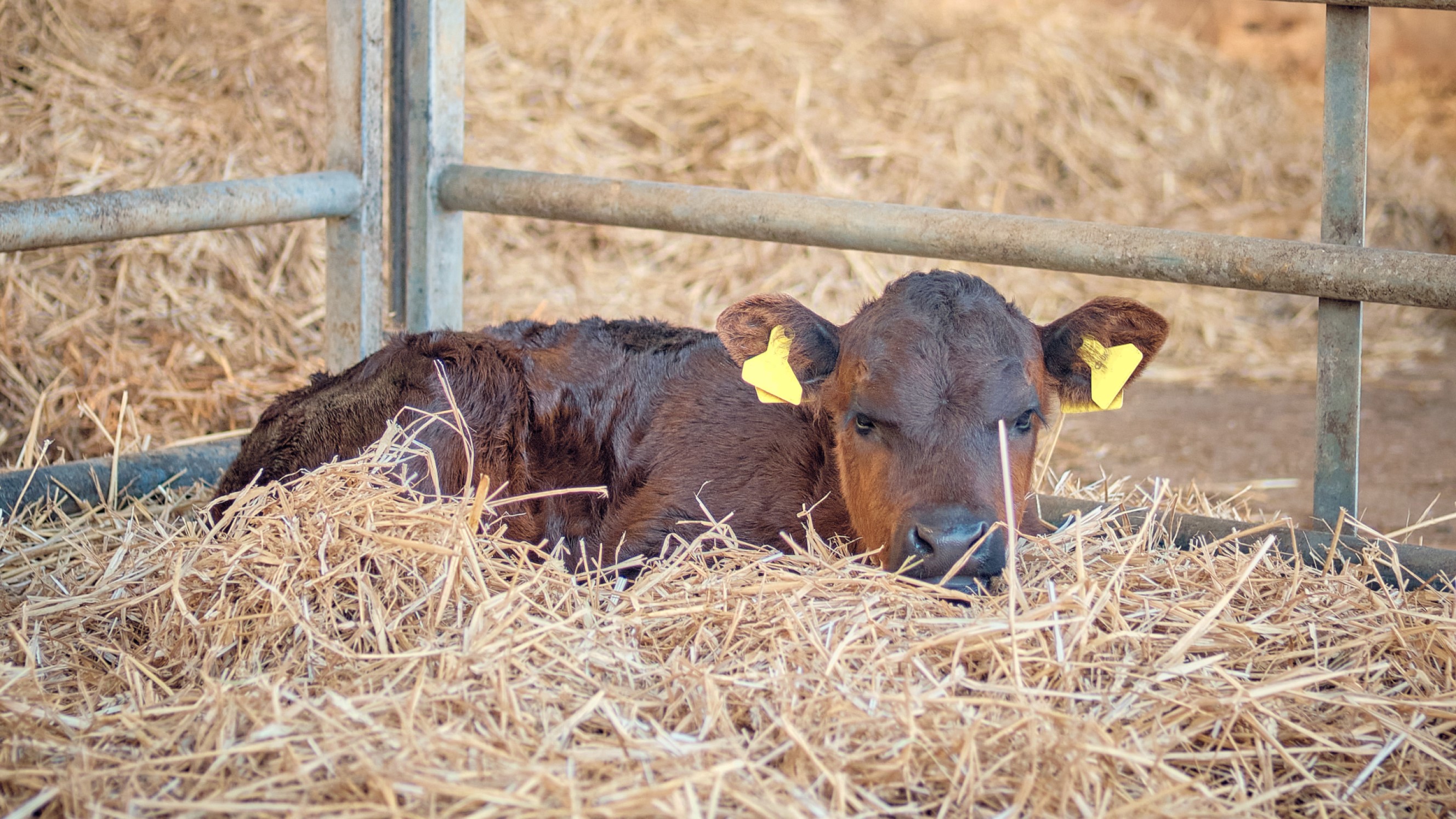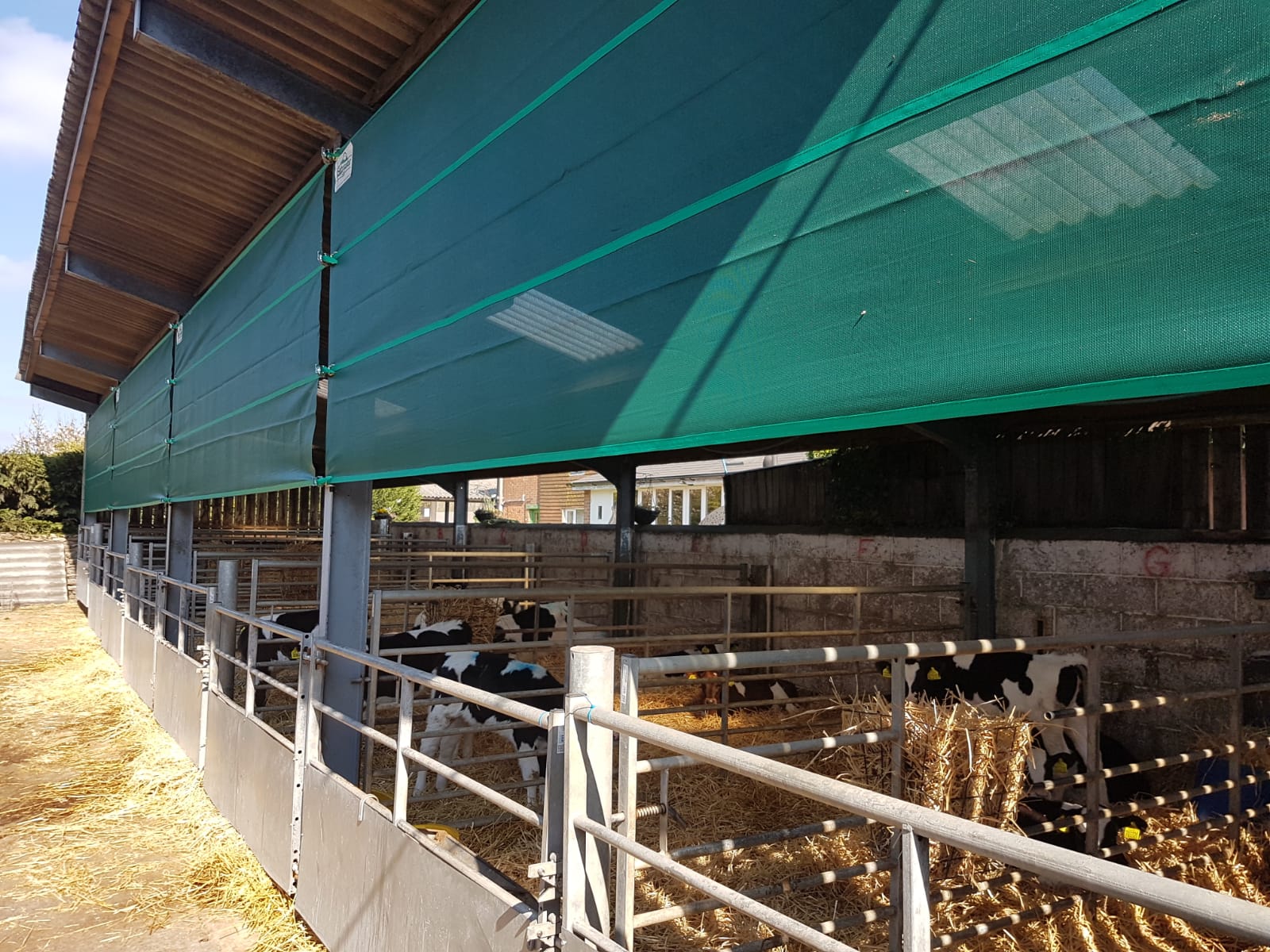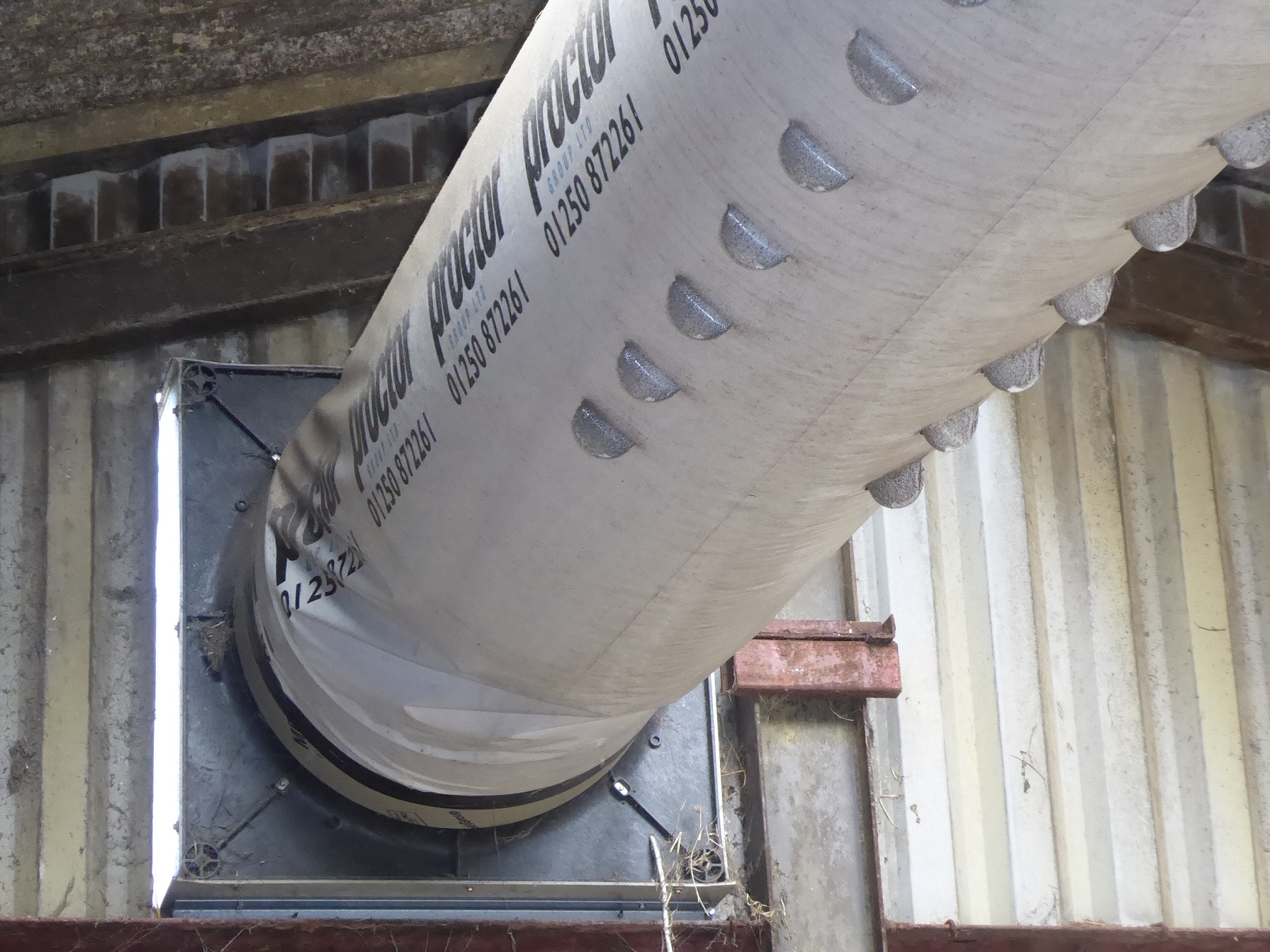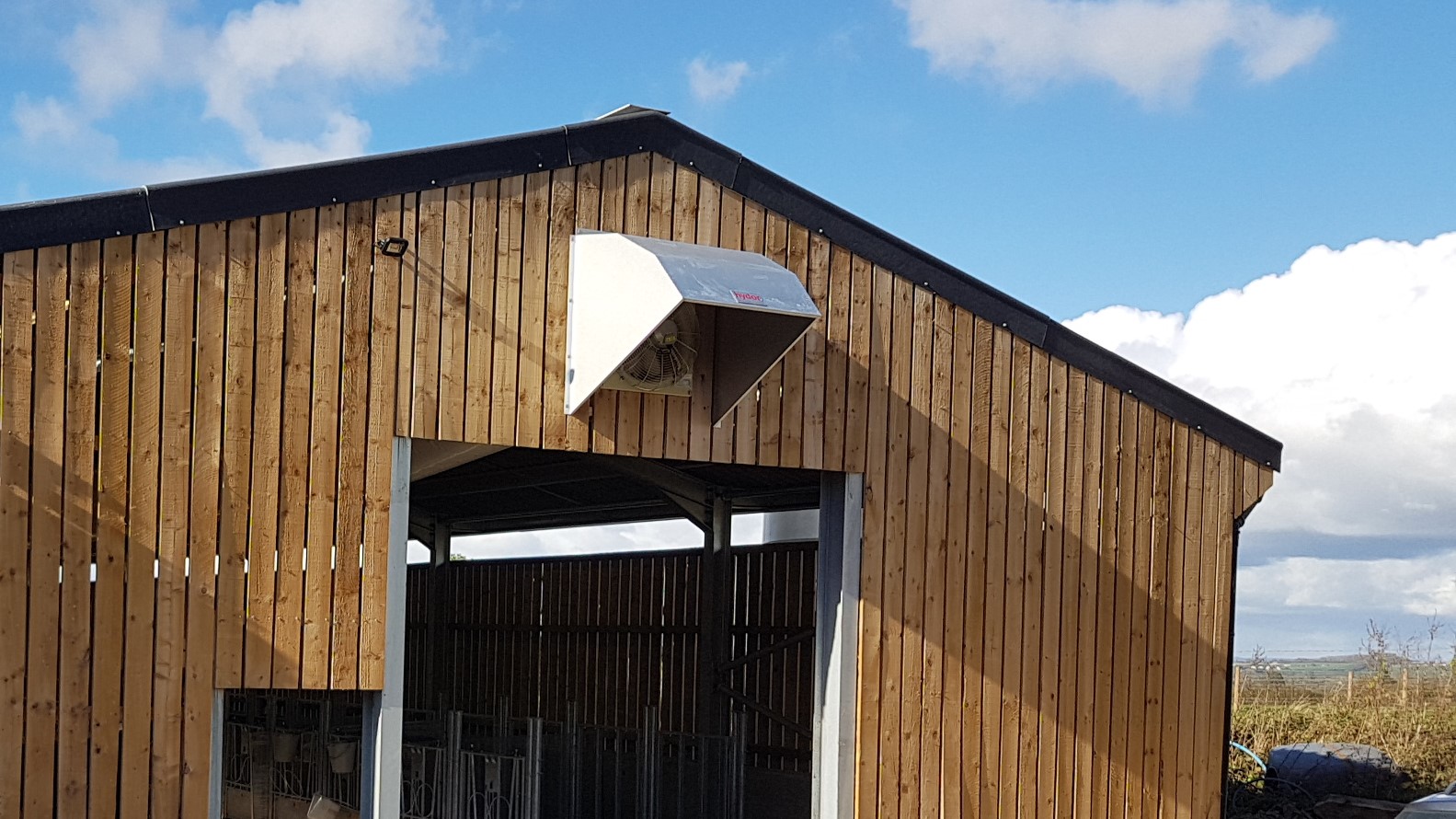- Home
- Knowledge library
- Youngstock housing – Temperature, humidity and ventilation
Youngstock housing – Temperature, humidity and ventilation
The calf’s ability to maintain a steady body temperature develops during the first eight weeks of life. Regardless of the housing system, a newborn calf will feel cold when the temperature drops below 10–15°C. By the time it is four weeks old, a healthy calf can tolerate a wider range of ambient temperatures.
While absolute temperature is important, the role of humidity should not be underestimated. Humidity can directly impact calf physiology and create an attractive environment for bacteria and viruses. Control of humidity in calf housing requires a combination of good drainage and effective ventilation, so the design of building sidewalls is a critical aspect of good calf house design. Most systems require mechanical ventilation to provide clean air at all times.
Temperature
When a healthy calf is over 8 weeks old, it can thermoregulate reasonably well and maintain a constant body temperature of around 38°C.
The thermoneutral zone for a calf is the temperature range when the calf does not have to expend energy to maintain its normal body temperature. The lower critical temperature (LCT) is the temperature below which the calf must burn extra energy to keep warm, while at temperatures above the upper critical temperature (UCT) the calf must try and dispel the extra heat to avoid heat stress.
The design of any calf housing system must take into account that a calf less than eight weeks of age has a reduced natural ability to regulate its body temperature. While a newborn calf must change its behaviour and burn extra energy below ambient temperatures of 10–15°C to maintain body temperature, a healthy calf at four weeks of age can comfortably cope with temperatures closer to freezing.
The temperature felt by a calf is a combination of the ambient air temperature, airspeed and relative humidity. The calf can lose heat through evaporation, radiation, conduction and convection, although this ability is relatively poorly developed in a calf less than eight weeks old.
It is strongly recommended to invest in a max-min thermometer (or a digital data logger if possible), placed at calf level, to monitor changes in temperature in the calf shed. This enables appropriate action to be taken where and when required.
Table 1. The temperature the calf feels is a combination of temperature, airspeed and humidity
| Age (weight) | Lower critical temperature °C at air speeds of: | |
|---|---|---|
| 0.2 m/s (draught-free) | 2.0 m/s | |
|
Newborn (35 kg) |
9 |
17 |
|
1 month (50 kg) |
0 |
9 |
Webster, 1981
As well as reacting to the environment within the housing facility, a calf can attempt to thermoregulate by adjusting its behaviour. When a calf feels cold, it will spend more time lying down, which reduces the external body area exposed to the atmosphere.
 Matt Brodie Photography
Matt Brodie Photography
In some cases, the calf will lie with all four legs tucked under its body to reduce heat loss and will exhibit nesting behaviour when it tries to burrow into the bedding material.
Humidity
The impact of ambient temperature on calves is confounded by the level of relative humidity or how damp the environment is. The rate of energy loss from a body at a low set temperature will increase with higher humidity: cold plus damp ‘feels’ colder than cold plus dry because the rate of heat loss from a body is greater. The same is true with damp bedding, where the rate of energy loss from a calf to the environment is higher than on a dry bed.
The capacity of air to retain moisture reduces as the air temperature drops towards freezing point. This leads to high relative humidities at low air temperatures, typical of UK winter housing environments. High humidity and poor airflow in a building can result in pathogen build up and heat-stressed calves, even in cooler months.
The link between temperature and humidity is described as the Temperature Humidity Index (THI), which is normally used to describe warm and hot conditions.
When THI is greater than 72, calves start to exhibit evidence of heat stress. These conditions can be created between 22.2 and 26.6°C, depending on the relative humidity.
Table 2. The effect of temperature and humidity on the temperature humidity index and heat stress in calves
| Temperature (°C) | Relative humidity (%) | ||||||||
|---|---|---|---|---|---|---|---|---|---|
| 20 | 30 | 40 | 50 | 60 | 70 | 80 | 90 | 100 | |
| 15 | 59 | 59 | 59 | 59 | 59 | 59 | 59 | 59 | 59 |
| 20 | 64 | 64 | 65 | 65 | 66 | 66 | 67 | 67 | 68 |
| 25 | 69 | 70 | 71 | 72 | 73 | 74 | 75 | 76 | 77 |
| 30 | 74 | 75 | 77 | 78 | 80 | 81 | 83 | 84 | 86 |
| 35 | 78 | 81 | 83 | 85 | 87 | 89 | 91 | 93 | 95 |
Temperature humidity index:
59–71 = Comfortable 72–78 = Heat stress 80–95 = Severe heat stress
Improved moisture management should be included in the design of any calf housing system. It is not uncommon to see 83–98% relative humidity in UK calf units.
Not only does humidity influence the temperature felt by the calves it can increase the survival rate of bacteria and viruses. For example:
- Cryptosporidium can survive outside the host for six months in damp conditions between 5 and 15°C
- Rotavirus can survive in a damp environment at around 20°C for months
- Mycoplasma species can remain viable for at least 30 days
- Salmonella species can remain viable for more than 50 days in damp conditions
Control of humidity in calf housing requires a combination of good drainage and effective ventilation.
Dust and gases
Dust and gases can adversely affect the health of a calf, and some of these effects extend through to lactation. Dust from poor-quality bedding is especially damaging to the lungs. Airborne particles will contain very fine aerosols of bacteria and spores of moulds and fungi. These can penetrate the deepest parts of the lungs and have a significant biological impact.
Ammonia levels at 25 ppm will irritate mucous membranes and increase the animal’s susceptibility to respiratory disease, while carbon dioxide (CO₂) and hydrogen sulphide (H₂S) can limit future development.
The information above highlights the importance of good ventilation in calf housing to remove humidity, dust and gases without causing the environment to become cold.
Ventilation
A constant supply of fresh air is essential in preventing respiratory diseases and infections.
Good ventilation removes stale, humid air. Stagnant air contaminated with dust, moisture, ammonia and viruses, which can cause pneumonia, must be removed and replaced by fresh air. Cobwebs in buildings and condensation on the underside of roofing are signs of poor ventilation.
Movement of air within a calf shed can be visualised using smoke pellets. This helps to highlight stale pockets of air and demonstrates where air is moving. Airspeed can also be measured using an anemometer.
To ensure adequate ventilation, it is important the building is designed or adapted to:
- Remove excess heat
- Remove excess water vapour
- Remove microorganisms, dust and gases
- Provide a uniform distribution of air
- Provide correct air speed for the stack effect
When designing a calf housing system, it can be challenging to balance the need for fresh air with the detrimental effects of draughts (Table 3).
Ideally air speeds at calf height should be around 0.25 m/sec. Any air speed greater than this is considered a draught.
Table 3. Effects of different air speeds on calf health
| Airspeed at calf level (metre/second) | Significance |
|---|---|
|
0.15 |
Stale air – increases pathogen survival and reduces airway function, increasing the risk of pneumonia |
|
0.20 |
Draught-free |
|
0.30 |
Draught on calf – calf will become chilled |
The stack effect and heat distribution
A common principle of ventilation in cattle buildings is the stack effect, which can come into effect when wind-driven ventilation is not present. The heat generated by cattle within the shed warms the stale air. This creates thermal buoyancy through the outlets in the roof, which creates a negative pressure when fresh cooler air is drawn into the building from the side inlets.
Unfortunately, young calves generate insufficient heat to initiate the stack effect. This can lead to poor natural movement of air within the building. This is common in buildings with insufficient exposure to the wind, and is compounded during periods of low or no wind.
.jpg)
Achieving good ventilation
There is an absolute requirement for clean air in animal housing and for the removal of stale air. Nearly all cattle and calf buildings are ventilated by the pressure from the wind, with clean air entering one sidewall and exiting the opposite wall, due to pressure differences. An ideal building will have equal amounts of openings in every wall so that it can manage the wind from any direction.
Common ventilation failures to avoid include:
- No inlet in two or more walls; no clean air delivery to part of a building
- Big differences in inlet areas in each wall; this can lead to turbulent airflow within a building
- Inlets with wide openings (>25 mm) that create increased airspeed at calf height. Wide openings are not a problem when located so that they do not cause increased airspeed at calf height
- Unbalanced distribution of air inlets, leaving some areas inside a building exposed to increased airspeeds, and other parts with insufficient clean air
- Shared air space with older animals
- High-volume air space; while some believe this achieves good air quality in calf houses, it, in fact, has the opposite effect
- No roof-level outlet
All of the above means that the design of the sidewalls is a critical aspect of good calf house design.
Outlet areas on the roof are essential. Ventilation only works correctly if there is a balance of inlets and outlets. When buildings are located so that the wind has access on all four sides, wind-driven ventilation crosses the floor area from side to side or end to end. However, many locations will not provide wind access from all sides, and the design of an outlet in the roof has a major impact on assisting in the removal of stale air from a building.
The outlet area should be a minimum of 0.04 m² per calf and typically at least 1.5 m above any inlet. Inlet areas should be a minimum of 0.08 m² per calf (0.04 m² in each sidewall).
The optimum design of an outlet for calf housing is a covered open ridge. This provides an exhaust for the occasional periods when warm air accumulates in the building and is essential for providing a high-level outlet in the roof when mechanical ventilation is used.
 Aaron Brown
Aaron Brown
A covered open ridge is an optimum outlet.
A raised open ridge, though popular with some builders, does not provide a negative pressure to assist exhaust air at any time.
Lack of clean air delivery remains a critical weakness in many calf house systems. This occurs in all systems if:
- There is any compromise in wind-driven inlet areas in the sidewalls
- The wind stops blowing
Most systems require mechanical ventilation to provide clean air delivery at all times.
Improving ventilation with building design
Modify sidewall cladding
Many buildings used to accommodate young calves can be improved by modifying the sidewall cladding (or inlet ventilation) to improve the natural airflow into the building. This, however, must achieve the difficult balance between airflow and draught.
 AHDB
AHDB
Yorkshire boarding
Ventilated cladding or Yorkshire boarding on all aspects can help improve airflow. Conventional space boarding does not eliminate driving rain or higher wind speeds.
.jpg)
Positive pressure tube ventilation (PPTV)
Where natural ventilation is not sufficient, the area will benefit from some type of mechanical ventilation. Well-designed positive pressure tube ventilation (PPTV) systems ensure that air flows at all times and have been associated with reduced levels of respiratory illness in calves. A fan fitted to the wall or to one end of a building, blowing air over pens without a tube, does not deliver fresh air. Fresh air may be delivered in the initial part of the air plume, but thereafter the air becomes increasingly dirty along the length of the plume. When the trajectory of the air plume ceases, between 6–10 m from the fan, the result is a concentration of stale air and an increased risk of disease transmission.
 Jamie Robertson
Jamie Robertson
The fan capacity should be between 35–105 m3/h per calf. Fan controls must be such that the lower figure (35 m3/calf) is always maintained, i.e. the fan must never be shut off. The upper figure is to provide adequate ventilation when calves have attained higher body weights and for summer ventilation. It is vital that there is contingency planning in the event of power outages, especially in hot weather, to prevent heat stress.
The fan controller should be set up so that the minimum ventilation rate is always maintained. The requirement is to have the fan and tube designed so that fresh air is delivered into each pen at an airspeed of less than 0.3 m/s at around 1.2 m height. The target is to deliver clean air, whatever the external weather conditions (windspeed and temperature), with no draught at animal height.
.jpg)
Fan performance (m3/h) is provided by the manufacturers to guide selection of a suitable product. A common failure is to select fans based on stated performance against zero resistance (0 pascal), i.e. with no resistance created by the ducting, the tube or the prevailing wind. The actual requirement is to use a fan with the required performance (m3/h) at a resistance of 50 pascals. Fans also require an air flow straightener on the output side before the attachment to the tube. Standard tubes and fans generally only work in standard-sized and configured buildings. Fan size and tube configuration should be provided by someone who knows how to configure the size, number and location of holes in the tube to deliver clean air on target.
 Jamie Robertson
Jamie Robertson
Fans in most sidewall locations benefit from an external cowl to protect the fan and provide more consistent operation.
Information required to specify which PPTV system to choose:
- Length of area to be ventilated
- Width of area
- Eaves to ridge height
- Maximum number of calves housed
- Height of tube above pen floor area
- Horizontal location of tube across the width of building
The length of area to be ventilated and the width of area are easy to determine in a dedicated calf building. When compromises are needed, and the calf rearing area is part of a larger building space, you should consider targeting only the calf pen areas.
.jpg)
There are many reasons for a tube to be located at a specific height and horizontal location above the pens. Restrictions on fan placement or requirements during mucking out with large machinery often dictate the position of the tube. The design of the tube can accommodate a wide range of locations and still deliver clean air into the breathing zone of calves, if the correct information is given to the supplier.
Air space
Air space is as important as floor space, and BS5502-40:2005 outlines minimum air space for housed calves from birth to seven months old (Table 4).
However, it is essential to note that air quality directly influences animal health and performance, and that air volume per calf is not a measure of air quality. It can be especially difficult to provide consistent and effective ventilation that delivers good air quality in larger-volume calf buildings.
Table 4. Minimum air space for housed calves from birth to seven months old (BS 5502-40:2005)
| Weight of calf (kg) | Air capacity per calf (m3) |
|---|---|
|
60 |
6 |
|
61–85 |
10 |
|
86–140 |
13 |
Read more about youngstock housing
Legislation and market requirements
Housing layout and construction
Designing housing to feed calves with ease

